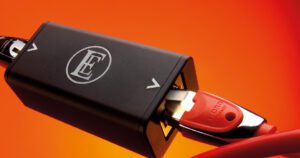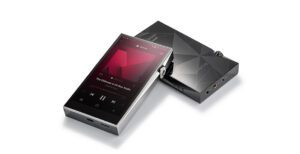JMF Audio PRS 1.5/HQS 9001 line preamplifier and mono power amplifiers
- REVIEW
- Alan Sircom
- Oct 25, 2023

There’s an unspoken rule in high-end electronics; make a ‘good, better, best’ range of products. That way, some can start small and dream big, while a few can just go straight to the summit, and others can run two or more systems from the same brand. JMF Audio does precisely none of these things. Instead, it just went straight for ‘best’.
There’s no ‘diffusion line’, no entry-level, not even an integrated amplifier version of the company’s PRS 1.5 preamp and HQS 9001 power amplifiers. Granted, there is some hierarchy in the trio of power amplifiers. However, this is more attuned to ‘system matching’ than performance improvements and enhancements. The dual mono nature of the amplifier remains the same whether they share a single chassis (the HQS 6002), are powerful enough mono amps for most loudspeaker systems (the HQS 7001) or are designed to drive absolutely any loudspeaker in any room (the HQS 9001 tested here). This stance is one that held JMF Audio in good stead when it predominantly made top‑notch amplifiers for equally top-notch studios.
Simply the best
This resolute ‘simply the best’ position does mean the brand flies under the radar when compared to the brightest stars in the audio firmament. It’s a hand-built line that doesn’t suffer from ‘Mark-Two-Ism’ or ‘upgraditis’. It’s a small range of amplifiers that music lovers remain so happy with they effectively fall off the audiophile bandwagon and stop buying and selling amps. It’s a range that doesn’t include a first-rung product and comes with a tidy waiting list to own one… no wonder it isn’t one of the names that audiophiles see on every trip to the store.
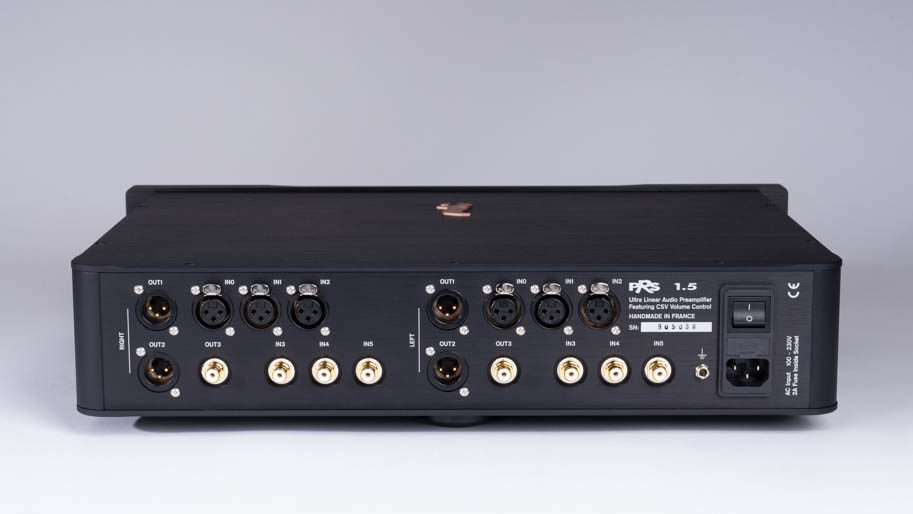
Starting with the JMF Audio PRS 1.5 preamp then, this is a line-only, dual-mono design, with three balanced inputs and three single-ended inputs and two balanced and one single-ended output. Although the PRS 1.5 does sport some solid-looking RCA sockets on its rear panel, the preamp (like every product in the JMF Audio range) uses a fully balanced circuit, with the single-ended signals taking advantage of the preamp’s SSA ‘Super Symmetrical Analogue’ technology immediately after the input itself. The input stage – developed for the power amplifiers – is a hand-calibrated proprietary precision module, capable of an impressive 100dB of common mode interference rejection. This is one of the eight points of manual calibration performed on the PRS 1.5 in the JMF Audio factory, and that requires a 100-hour soak-test/burn-in period. Sitting on a shelf for almost five days not only means the preamp is sufficiently settled in to perform that calibration but also means out of the box this needs minimal run-in at home.
At the heart of the PRS 1.5 preamplifier is JMF Audio’s proprietary ‘CSV’ volume control. This is a fully passive volume control that uses digitally controlled stepped attenuators and is sealed and shielded from the rest of the circuit in a block of aluminium. This CSV design takes advantage of the best parts of other passive volume controls (no noise, distortion or phase shift and no reduction in dynamic range) but without the downsides (poor channel symmetry, too many noticeable volume steps, and limited remote-control options). JMF Audio has also cracked the low gain problem around passive volume controls by buffering its input and output; this is because of a lot of research into the sonic neutrality of passive components and relies on JMF Audio’s use of either bespoke components or ones used in fields outside of audio, such as instrumentation design and military-grade devices built for the long game.
The long tail of the amp
The HQS 9001 has a long tail. It reflects the original designs that put JMF Audio power amplifiers into high-end recording studios around the world. From the outset, those amplifiers were designed to deliver large energy reserves with both a high-current output (to control any loudspeaker or speaker driver to which they were connected) and a design that incorporates high-voltage electronics (making higher efficiency designs with greater headroom than their peers). This worked well 38 years ago when the company was founded and works just as well today, albeit with a lot more refinement to the circuitry over the intervening decades.
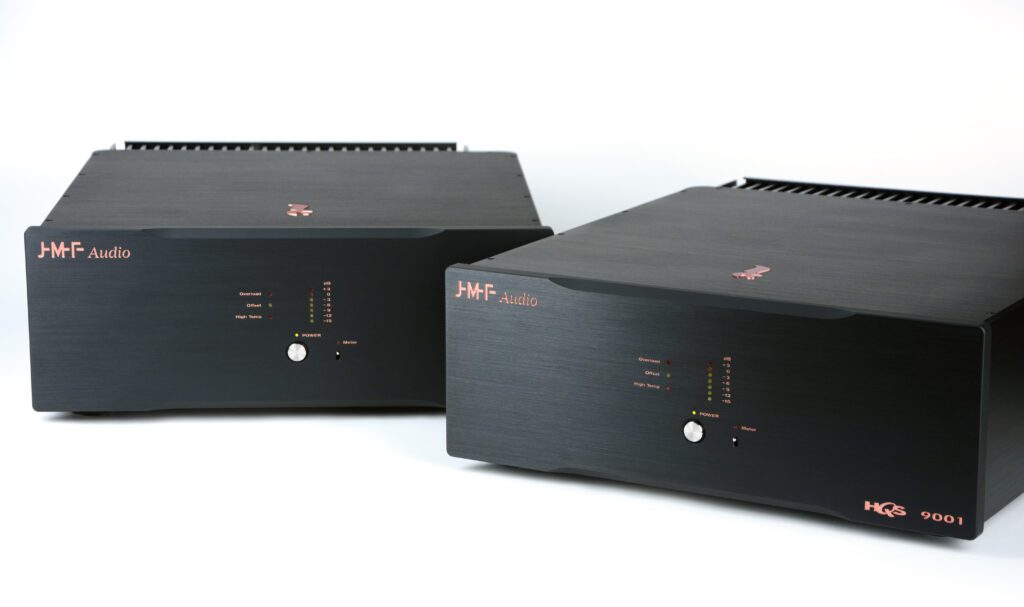
JMF Audio’s power amps hark back to the background of Jean-Marie Fusilier himself. Trained in high-frequency, infra-red and power electronics – and being a music lover who built his own tube amps in his spare time – he knew his way around precision electronic circuitry and felt he could leverage his past to make high-output power amplifiers with drive, precision, and as little noise as possible. In the process, tube amplifiers fell by the wayside, but their inherent high-voltage circuits still acted as an inspiration.
Fast forward to today and Jean-Marie’s sons run the business and have only built on their father’s original designs. The centrepiece of today’s JMF Audio power amps is the LDA mono driver board. This controls voltage amplification, providing over 30dB of gain to the incoming line-level signal. As in the preamplifier, this symmetrical circuit is hand-calibrated after 100 hours of burn-in and enables 100dB of common mode interference rejection.
This LDA input stage is met by a DCS for a direct-coupled, capacitor-free servo proprietary and an MTP type output stage with 42 selected transistors per channel, all individually controlled. This feeds into a DPO direct output with no output inductance. The whole amplifier is thermally regulated using what JMF Audio calls a TRB circuit, all of which sit on a PGP analogue circuit board, inside an SCD-sealed case and 120A-rated 6mm output terminals known as LSS.
The result of all these three-letter acronyms is a DC-coupled mono power amplifier that can deliver 600W into an eight-ohm load and 3kW into one-ohm loudspeakers. It can pump out 330A of current too. As far as power amps go, these ones could be used to jump-start a Boeing.
More watch than amp
While most brands use regular printed circuit boards and some use high integration intended gold finishes of only a micron of thickness, JMF Audio developed a proprietary gold plating (the PGP process mentioned earlier) for which its own bespoke solder is used. This solder is more like the sort used in fine jewellery, and JMF Audio’s technicians build components under high-magnification conditions, closer to watch-making than amp-building! Of course, where flow and wave soldering are impossible to avoid (such as in digital audio devices), it’s used, but JMF Audio’s preferred methods of construction are very much on the solid side of things.
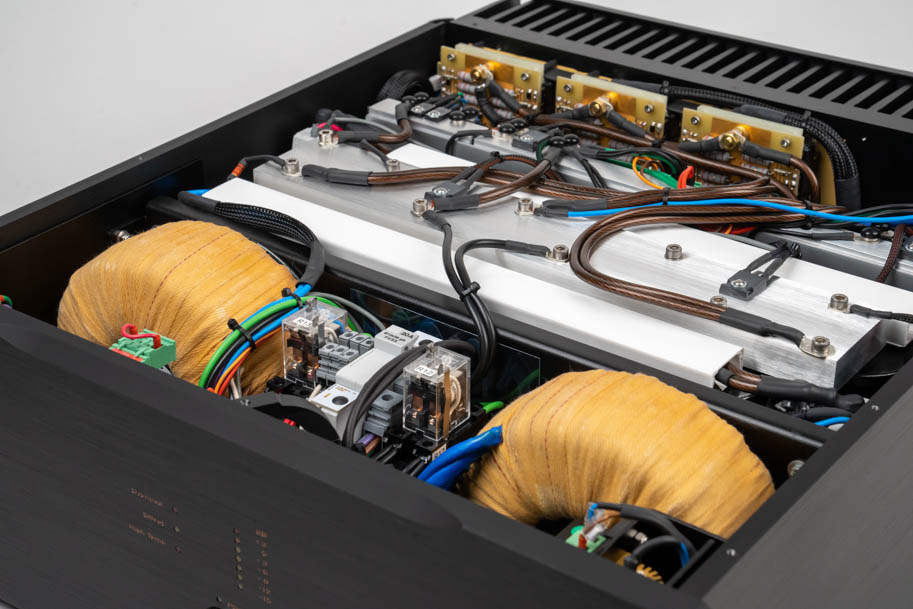
‘Solid’ holds universally for JMF Audio. Companies that laid pro-audio foundations in the time of the Titans of the studio world all have one thing in common; they build their products well. OK, some of those brands have been through several iterations and are now a shadow of their former selves, but not JMF Audio. This is a brand that built products in the old-school way, with solid over-engineering in all the right ways. Nothing shifts, nothing breaks, nothing gets in the chassis unless it’s made to last. Lots of companies talk that talk, but precious few companies build quite as steadfastly as JMF Audio.
Just how solidly built? With the Doomsday Clock currently set at 90 seconds to midnight, I am all too aware that I live relatively close to three main targets, and in the event of impending thermonuclear Armageddon, I would barely have enough time to boil an egg before I’m turned to dust. So, it is reassuring to know that millions of years from now, when the irradiated glass that used to be the planet is starting to be repopulated by whatever species evolved to carry the big-brained baton we so assiduously dropped, they will have a few nice sets of JMF Audio amplifiers to play with because these things will damn well survive practically everything.
Goal-reaching
At the very top of the top-end of high-end audio, manufacturers often design products that reach for a specific musical goal (or goals) and while they are good in other fields, it’s their area of excellence that defines that sound. However, it’s refreshing to report that JMF Audio instead makes an amplifier that delivers the goods. All the goods. It delivers them uniformly well and does so with great power, great control, and great precision. The JMF Audio amps just do everything right, without highlighting or exaggeration.
It is a great combination, well matched. Both the preamplifier and power amp get out of the way of the signal superbly well, with both delivering a sound that is detailed, dynamic and vivid, but not pitched forward. It’s just insight into the music, rather than the intricacies of your system.
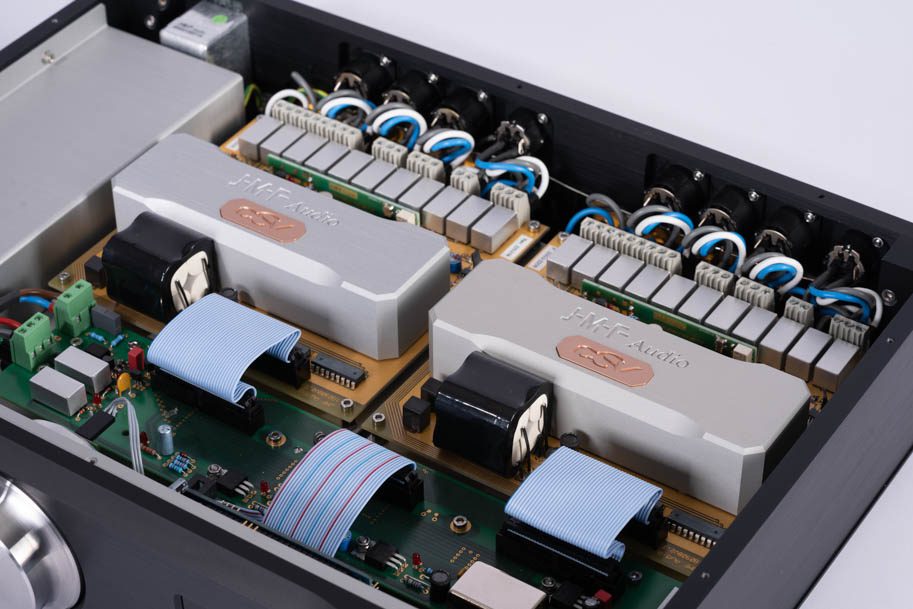
Somehow, we erroneously equated this insight with brightness, but in the JMF Audio combination you see this as false; insight into the signal and the music is neither bright nor dull; it’s just honest. Not starkly honest or boringly honest, more complete accuracy and a strong degree of faithfulness to the original signal. Isn’t that the goal of ‘high-fidelity’?
Moreover, you begin to realise just how most other amps that purport to do the same honesty fall short somewhere. They are more veiled, less open, less dynamic, less detailed, and less accurate than the JMF Audio combination.
These amplifiers are the ultimate in signal transfer between source and loudspeaker. That signal is neither added to nor subtracted from and moves through the signal path in as unsullied a way as possible. As soon as you begin to replace the word ‘signal’ with ‘music’ you begin to get an understanding of just how rare such things are. Most amplifiers mess with the soundstage width or depth slightly, they either accent or push back the rhythmic properties of the music, flatten dynamics or compromise – even mildly – one aspect of the musical whole. These amps… don’t.
But the music itself is sublime. As you might expect, it is supremely accurate and faithful to the original recording no matter what. My go-to Joyce DiDonato album [Stella Di Napoli, Erato] had her voice thrillingly rise out of the silence with all the force that a powerful mezzo-soprano can deliver. Yet, it had the power to control that too; her voice soared when needed and yet never overstated itself and the interplay between voice and French Horn at the end of the aria was an exercise in right-sized dynamics, spatial properties, detail and fluidity.
I also played a lot of tracks of all musical genres, including some that I rarely bring up in audio reviews, even if they are musically strong. Playing ‘I’m Jim Morrison, I’m Dead’ from Mogwai’s The Hawk Is Howling album [Wall of Sound] the intensity of the slow build was – and should be – trance-like, but here the amps had dynamic range to spare, and that made Mogwai seem so powerful that it was like musical sunburn, even at relatively quiet levels.
No bragging
There’s just one downside; the absence of bragging rights! The typical high-ender may not have heard of the brand in part because JMF Audio almost never appears on the second-hand market; there is nothing left to upgrade from here. As you won’t find a preamp that does what the PRS 1.5 does elsewhere, so you won’t swap it for The Next Big Thing. Similarly, I find it hard to imagine what you might buy after owning a pair of HQS 9001s. And as the company doesn’t make a new product every year, they don’t get the exposure of other, more attention-grabbing brands. And finally, the JMF Audio products make a sound that is so intrinsically ‘right’ isn’t going to be as ‘bling!’ as one that shouts from the rafters.
An often stated – and rarely observed – goal of good audio amplification is ‘a straight wire with gain’. It speaks of an amplifier system that gives or takes nothing and instead makes a sound as accurate – and musically cogent – as it is possible to make. Most get some of the way toward that goal but end up falling short. JMF Audio’s PRS 1.5 and HQS 9001, on the other hand, nail the whole ‘straight wire with gain’ task beautifully and shows just how far we need to go – and how much you must spend – to get a truly honest amplifier system.
Technical specifications
PRS 1.5
- Type solid-state line preamplifier
- Inputs 3× XLR balanced, 3× RCA unbalanced
- Outputs 2× XLR balanced, 1× RCA unbalanced
- Input impedance >10kΩ (XLR and RCA)
- Output impedance 50Ω
- Max Input level 3V (XLR)/1.4V (RCA)
- Maximum output level 10V into 10kΩ load
- Frequency Response 1Hz-150k (intentionally limited for RF immunity) 20Hz–20kHz (±0.0dB)
- Signal to noise ratio 120dBA (+22dBu)
- THD+N 0.0002% typ. (+22dBu, 1kHz)
- Channel separation >100dB
- Finish Black or Silver
- Dimensions (W×D×H) 48.2 × 32.6 × 10.6cm
- Weight 12kg
- Price £32,000
HQS 9001
- Type solid-state mono amplifier
- Input XLR
- Outputs 6mm loudspeaker terminals
- Power output 600W/8Ω, 1000W/4Ω, 1700W/2Ω, 3000W/1Ω
- Frequency response 3Hz–100kHz (-3dB), 3Hz–40kHz (0dB, intentionally limited for RF immunity)
- Noise floor and hum Better than -125dB unweighted 1kHz
- Finish Black or Silver
- Dimensions (W×D×H) 48.2 × 60.5 × 18.5cm
- Weight 54kg (ea)
- Price £128,000 per pair
Manufacturer
JMF Audio
Distributor
Audioskies
Tags: JMF AUDIO LINE PREAMPLIFIER MONO POWER AMPLIFIERS PRS 1.5 QS 9001
By Alan Sircom
More articles from this authorRead Next From Review
See all
PrimaLuna EVO 100 phono preamplifier
- Apr 22, 2024

Reiki Audio SuperSwitch Master Pro + Servant Pro
- Mar 27, 2024

Melco Audio N1-S38 music server
- Mar 27, 2024








